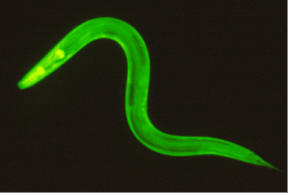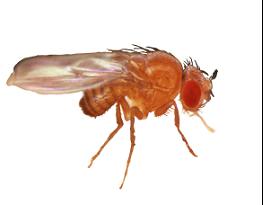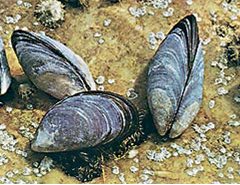This Thesis Research Project is directed by Prof.Silvia Atrian and Prof.Mercè Capdevila.
Jordi Domenech Research Project
Go to Jordi's Metallothionein Research Page.
|
Slide 1 of 10 |
1.-A general study on the structure-function relationship in MTs
My research subject deals with the relationship between the primary structure of plant, Protozoa and Invertebrate Metallothioneins and several aspects of their molecular features, including peptide folding, metal-binding abilities, metal coordination preferences and structure, in order to get information about the chemical and geometric functional constraints defining the evolutionary paths of this family of proteins.
To this aim, we aborded the characterization of the metal-binding behaviour of several representative MTs, listed here bu the methodology described in "How we study MTs".

2-Nematoda Caenorhabditis elegans CeMT2.
3-Insecta Drosophila melanogaster MTNA, MTNB, MTNC, MTND.
4-Echinoderma Stryngulocentrotus purpuratus SpMTA.
5-Molluscan Mytilus edulis Me10MT-IV.
6-Crustacean Homarus americanus MTH.
8-Protozoan Tetrahymena pyriformis TpMT1.
9-Sulphides in Metallothioneins
.
Jordi Domenech Research Project
|
Slide 2 of 10 |
There are few data on the literature about the folding of this MT or its metal preferences.
The presence of a C-terminal Histidine is not habitual in MTs, and our first results show that this Histidine residue could play a principal role in Metal cordination.
This studies have been object of a communication, available at the Publications section.
The characterization of the Metal-binding habilities of CeMT2 is a collaboration between the UB and UAB Research groups, directed by Prof. Mercè Capdevila and Prof. Silvia Atrian.
MVCKCDCKNQNCSCNTGTKDCDCSDAKCCEQYCCPTASEKKCCKSGCAGGCKCANCECAQAAH

Slides 1, 2, 3, 4, 5, 6, 7, 8, 9, 10
.
Jordi Domenech Research Project
|
Slide 3 of 10 |
Drosophila melanogaster MTNA, MTNB, MTNC, MTND
MTNA and MTNB Drosophila MT forms show a preference for cooper, and Drosophila reveals to be the first metazoan which have not a Zn-preferent MT described. We are working in the characterization of two new Drosophila MT isoforms, MTNC and MTND.
The functional characterization of Drosophila MT forms is being performed in a collaboration between the UAB Research Group of Prof. Mercè Capdevila, the UB Research group of Prof. Silvia Atrian and the Research Group of Prof. Walter Schaffner, of Zurich University.
MTNA MPCPCGSGCKCASQATKGSCNCGSDCKCGGDKKSACGCSE
MTNB MVCKGCGTNCQCSAQKCGDNCACNKDCQCVCKNGPKDQCCSNK
MTNC MVCKGCGTNCKCQDTKCGDNCACNQDCKCVCKNGPKDQCCKSK
MTND MGCKACGTNCQCSATKCGDNCACSQQCQCSCKNGPKDKCCSTKN

Slides 1, 2, 3, 4, 5, 6, 7, 8, 9, 10
.
Jordi Domenech Research Project
|
Slide 4 of 10 |




